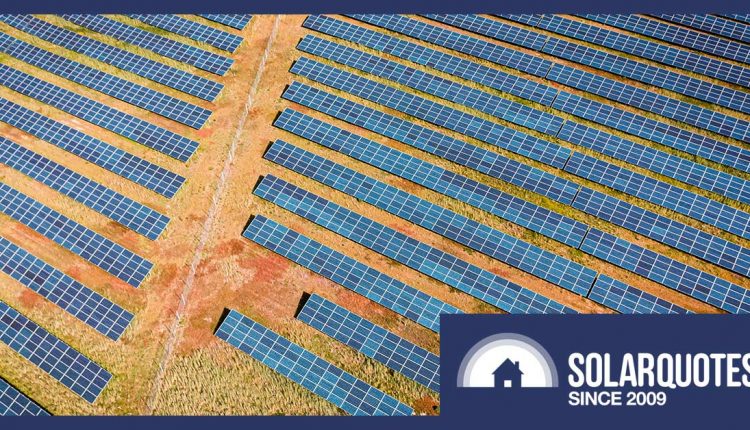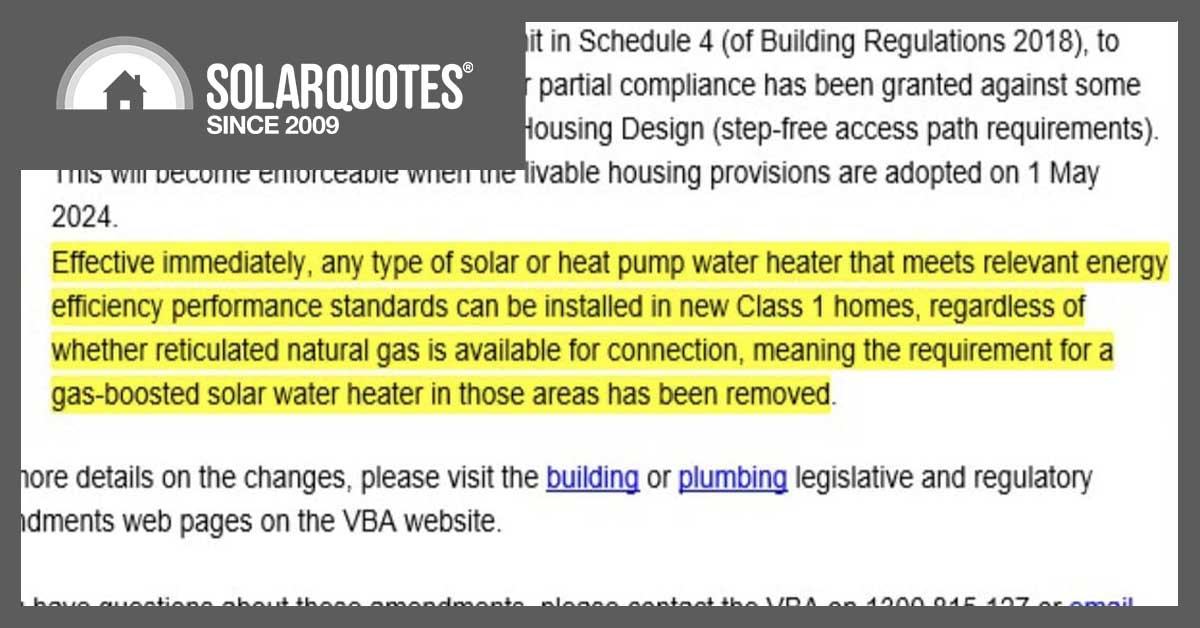I’ve Calculated CO2 Emissions From Solar Farm Land Clearing: It’s Bugger All.
The best place for solar panels is on your roof. Despite this, over one-third of our solar electricity comes from large-scale solar farms. Their construction can involve land clearing that releases carbon dioxide into the atmosphere.
These emissions aren’t good, but they are trivial next to those from fossil fuel generation.
This is because:
- Burning Australian coal releases roughly 1,000 times more carbon dioxide per kilowatt-hour generated.
- Coal mining results in vast amounts of land clearing. Even before the coal is burned, this may result in more emissions per kilowatt-hour generated than solar farms.
- When the land beneath the solar farm returns to its original use, regrowth will absorb carbon dioxide from the atmosphere roughly equal to what was originally released by land clearing.
Unlike coal mines, solar farms and agriculture can be combined. Under the right conditions, solar farms can increase the amount of vegetation land can support. But even in an — imaginary — worst-case situation where some lunatic bulldozed an old-growth forest to build a solar farm and no regrowth allowed, coal power will still emit over 300 times more CO2 per kilowatt-hour generated.
If you want to check my figures for this worst-case scenario, you can find them below. But first, I’ll make you read about how much land coal mining requires and how solar farming and real farming can go together.
Solar Farms — Big But Not That Big
Last financial year, solar energy provided 14% of Australia’s on-grid electricity. As most of our solar power capacity is on roofs, the approximately 11 GW of solar farms only produced about 5% of generation.
If we installed modern, 20% efficient, solar panels flat on the ground without gaps between them, 11 gigawatts would take up 57 square km. In practice, most solar farms have rows of solar panels with space between them to prevent shading. Land is also used for other purposes such as inverters and vehicle access. This may interest you : Trina Solar module proves mechanical reliability in a number of checks. In total, Australia’s solar farm capacity would cover around 100 square km. This figure may not be spot on, but it’s nice and round, so I’m running with it.
If all of Australia’s 100 square km of solar farms were arranged in one large square just outside of Sydney, it would look something like this:
While 100 square km is a lot of land, you can see it’s not that much in relation to a major city of 5.3 million.
Here’s what it would look like at the national level:
I’ve put a black square representing 100 square km of solar farms right under the letters “NT”. A nice, sunny, location for it. Since it’s hard to spot, I’ve also included a large red arrow. As you can see — or not see if your vision isn’t acute — Australia’s solar farms don’t take up a lot of land.
Even if Australia decided to generate its entire current grid electricity consumption from solar farms and increased the area they cover by a factor of 18, they’d still only cover this much of the country:
While they cover a lot of land, it’s still not that much in relation to the continent. Also, if it was all located in the middle of the Northern Territory, the black square would be smaller thanks to the location’s very high solar power output. If closely spaced solar panels were used, it could be about half that size.
Even if national electricity consumption doubled, we would not devote that much space to solar farms. Not when we still have so many rooftops we can put it on. But there is a possibility we will end up building considerable solar farm capacity to meet overseas demand through intercontinental electricity connectors such as Sun Cable’s Australia-Asia Power Link (AAPowerLink) project.
Coal Clears More Land
Solar farm land use is tiny in relation to how much has been cleared for coal extraction. On the same subject : Maxeon Solar Ink’s new IBC module supply agreement with SunPower. For example, South Australia’s Leigh Creek coal mine — now closed — covers a total area of around 70 square km.
This image is from the South Australian Government’s page on Leigh Creek Mine remediation. (I’m not going into coal mine remediation here, as that would require a hole article.)
Here’s what a black square representing the area of all Australia’s solar farms looks like next to it:
In 2007, its highest output year, coal from this mine generated 5,188 gigawatt-hours of electricity. Last financial year, Australia’s solar farms generated approximately 12,200 gigawatt-hours. In a year of below-average sunshine, Australian solar farms produced over two-thirds more electricity per square km than the Leigh Creek mine in its best year.
But solar power actually did better than that. Solar farm capacity is expanding rapidly and Australia had less at the start of last financial year than at its end. After accounting for that, solar farms produced approximately 84% more energy per square km than the Leigh Creek coal mine’s best year. This figure will increase as the efficiency of solar farms improves.
Not every coal mine is as spread out as Leigh Creek. But most of Australia’s production comes from open-cut mines rather than underground ones. I don’t have good figures for how much land is taken up by coal mining for domestic consumption. But, as most of our solar energy generation comes from rooftops, it seems almost certain to me that solar power requires less land clearing per kilowatt-hour generated than coal.
Solar Farms Don’t Have To Remove Vegetation
Solar farm construction often involves the removal or reduction of existing vegetation, but it doesn’t have to. See the article : array. Here’s an example from Germany of dual-use solar power and agriculture:
Image Credit: Fraunhofer Institute
The French decided that didn’t look weird enough and came up with this:
Image Credit: PV Magazine
Despite their efforts, as I pointed out years ago, the best solution may be to vertically install bidirectional solar panels that use sunlight falling on either side:
Image Credit: Photon Magazine
This leaves the space between panels wide open for agriculture, whether grazing or cropping.
In Australia, it’s usually not the amount of sunshine but water availability that limits vegetation growth. Ground-mounted solar panels can increase water availability by providing shade, cooling the ground, slowing wind speed, and allowing dew to drip from them. This can increase the total amount of vegetation that can be sustained. The fact less sunshine can help plants grow is familiar to many Australians who have struggled to mow thick grass in sheltered areas of the lawn that receives less sunshine.
Numurkah Solar Farm: Solar Energy + Grazing
It’s not just whacky Europeans who have combined solar power and agriculture. Here’s a video showing the Nurmurkah solar farm. It was built on grazing land and continued to be used for the same purpose after the solar farm was completed:
The carrying capacity of the land — how many sheep it can support — is around 80% as much as normal grazing land. But during a drought, it’s higher than land without solar panels.
Solar Farms Often Cause Land Clearing
Most Australian solar farms are not combined with actual farming. This is especially true for modern ones where solar panels are installed on frames in a factory and unfolded on-site. As the photo below shows, this often leaves very little open ground:
Maybe you can grow some shade herbs under there, but you’ll have to train goannas to harvest them. (Image Credit: 5B)
The fact these types of solar farms can’t combine with agriculture may appear to be an environmental minus, but this design provides two solid environmental benefits:
- It produces more energy per square metre, and so requires less space in total than a traditional solar farm.
- It lowers costs. This results in the very large environmental benefit of more solar farms being built, which reduces fossil fuel based electricity generation.
The downside is the area under the panels will support very little, if any, vegetation. While the land doesn’t have to be completely cleared like in the picture above, there simply isn’t much room for plant growth under them.
Regrowth Can Be Quick
Extracting fossil fuels and then burning them releases carbon that was trapped underground for millions of years. It takes an extremely long time for all the carbon released into the atmosphere to become trapped underground again. If you burn a kilogram of coal today, some of the carbon dioxide released will still be in the atmosphere 10,000 years from now.
Emissions from land clearing can persist in the atmosphere for a far shorter period. This is because the emissions come from the burning or decomposition of vegetation and associated fungi and animals. If the land is returned to its original use, then regrowth of vegetation and re-establishment of the local ecosystem results in carbon being drawn from the atmosphere by plants and being incorporated into biomass. This process may take decades if a forest is cleared, but for scrub or grazing land, which is what solar farms are usually built on, most of the reabsorption of CO2 can occur within a few years.
Mature Ecosystems Don’t Absorb CO2
Cleared land that’s left alone will absorb CO2 from the atmosphere as vegetation regrows. But this process will slow down over time and eventually stop.
In most mature ecosystems, the amount of CO2 absorbed and released is balanced. Exceptions, such as peat bogs and marine estuaries, are not likely places for solar farms. This means we only have to worry about emissions from land clearing itself, as uncleared land does not, normally, remove a net amount of CO2 from the atmosphere.
How Much CO2 From Solar Land Clearing?
CO2 emissions resulting from land clearing depend on three main factors:
- What type of land is cleared.
- How complete the clearing is.
- How much regrowth occurs.
If a solar farm is built on grazing land that’s used for the same purpose afterwards, this will result in little or possibly no total loss of vegetation. On the other hand, if a forest is fully cleared for a solar farm and no regrowth is allowed, considerable carbon dioxide emissions may result.
I will consider the maximum amount of CO2 emissions from building a solar farm in an extreme, worst-case scenario.
How Much Biomass?
According to Land Clearing — An Assessment Of Biomass Density, the maximum amount of dry biomass per hectare in Australia is around 110 tonnes:
No one ever cuts down dense, old-growth forests to build solar farms. There’s plenty of already degraded land that can be used. But I’m going to imagine a worst-case scenario where I bulldoze a forest, burn all the biomass, and poison the ground so nothing grows back. It will be the world’s most evil solar farm!
According to Nightcafe Creator AI, this is what an “evil solar farm” looks like. (Image Credit: A goddamn computer!)
Underground Biomass
The 110 tonnes per hectare figure only includes above-ground biomass. But this paper suggests there are around 25 tonnes of biomass below the ground for every 110 tonnes above. While some of this would remain below ground over the life of the solar farm, I’m going to assume all the carbon in it ends up being emitted as CO2. This brings the total biomass per hectare up to 135 tonnes.
Justin Jonson and David Freudenberger had this graph published on page 644 of the Australian Journal of Botany in December 2011. And I’m quite glad that they did. It saved me a lot of digging. (Image Credit: Australian Journal of Botany)
Carbon Content Of Biomass
The carbon content of dried plant material is around 40-50% by weight. I’ll use a figure of 44% because that’s the carbon content of cellulose — the most common plant compound. There will also be things like fungi, insects, and spiders mixed in with the plant material, but their carbon content will be similar. This means the total amount of carbon is nearly 60 tonnes per hectare.
When biomass is burned or otherwise decomposes, every atom of carbon will combine with two atoms of atmospheric oxygen. This added mass causes every tonne of carbon to create 3.67 tonnes of CO2 emissions. So in this worst-case scenario, clearing one hectare will result in the emission of 218 tonnes of CO2.
1 Hectare Solar Farm Electricity Output
A modern dense solar farm will cover around 90% of its total area with solar panels. While I used a worst-case situation for land-clearing emissions, I’ll assume its location is reasonably representative of Australian solar farms and place it near Dubbo in NSW. While the typical solar farm will have a mildly higher output than one there, it should be reasonably close to average.
A one-hectare solar farm near Dubbo that covers 90% of its total area with solar panels would generate around 2.66 gigawatt-hours per year. These days it’s reasonable to expect a solar farm to have a lifespan of 30 years. Over this time, assuming some deterioration in output, it would produce around 75 gigawatt-hours.
Dividing the 218 tonnes of land clearing emissions by this amount gives 2.9 grams of CO2 per kilowatt-hour of solar farm electricity generated.
Coal Is Over 300 Times Worse
If we ignore emissions from coal-related land clearing and only consider those from mining and burning coal in power stations, then each kilowatt-hour generated from coal releases around 1,000 grams of CO2. This makes coal 345 times worse per kilowatt-hour than my unrealistic, worst-case, estimate for emissions from solar farm land clearing.
Because solar farms are generally built in either open ground or scrub rather than our densest forests, a more realistic comparison would make coal around 1,000 times worse. But even before emissions from burning fossil fuels are considered, land clearing for coal mines may result in more emissions per kilowatt-hour generated than solar farms.
Also, we should consider that once a solar farm reaches the end of its life, provided the land is returned to its original use; regrowth will cause emissions from land clearing to be drawn out of the atmosphere. Generally, this process will mostly occur within just a few years.
This is very different from a coal mine. No matter how long you wait, it will never suck all the CO2 emitted by the coal out of the air.






Comments are closed.